文章信息
- 陈振, 阿不都卡地尔库尔班, 陈平, 林涛, 郭仁松, 张巨松
- CHEN Zhen, Abudukadier Kuerban, CHEN Ping, LIN Tao, GUO Rensong, ZHANG Jusong
- 花铃期高温胁迫对海岛棉干物质积累分配和产量的影响
- Effects of heat stress during the flowering and boll-forming stage on accumulation and distribution of dry matter and yield in island cotton
- 南京农业大学学报, 2020, 43(2): 223-230
- Journal of Nanjing Agricultural University, 2020, 43(2): 223-230.
- http://dx.doi.org/10.7685/jnau.201904064
-
文章历史
- 收稿日期: 2019-04-28
2. 新疆农业科学院经济作物研究所, 新疆 乌鲁木齐 830091;
3. 阿瓦提县气象局, 新疆 阿瓦提 843200
2. Institute of Economic Crops, Xinjiang Academy of Agricultural Sciences, Urumqi 830091, China;
3. Awati County Meteorological Bureau, Awati 843200, China
短期高温事件在全球范围内频繁发生, 且随着全球变暖而加剧[1]。据IPCC(Intergovernmental Panel on Climate Change)报道, 极端天气的出现将会严重影响全球作物的生长[2]。新疆是我国海岛棉种植的唯一生产区, 全年总降水较少, 且7—8月常有35 ℃以上的高温天气出现, 高温出现的强度和持续时间等已成为决定海岛棉高产稳产的主要生态因素[3-4]。因此研究高温胁迫对海岛棉生长和产量的影响具有重要意义。
高温胁迫导致棉花光合产物积累下降、呼吸强度升高, 进而引起植株生理性早衰、叶面积增长缓慢、植株矮化[5-7]。根据源库理论, 产量形成由光合作用与干物质转运共同决定[8]。作物生产力不仅依赖干物质积累, 还依赖于分配到经济器官的有效干物质, 这是高产的重要因素[9]。Oosterhuis[10]研究发现, 高温导致棉花产量下降的根本原因是碳水化合物供应不足, 而碳水化合物供应不足主要是因为棉株“源”端受到高温的影响。也有类似研究认为, 提高水稻整个生育期的最高气温, 将导致叶片衰老加速, 光合速率降低, 籽粒产量下降[11]。高温对作物的生长一般具有负影响, 但在自然选择作用下, 作物存在补偿能力[12]。李留勇[13]发现, 早期高温处理结束后, 水稻生长速率和地上部干物质较对照大幅增加, 表现出明显的补偿效应。作物对高温胁迫-恢复的响应方式是胁迫解除后出现短暂的快速生长以补偿胁迫造成的损失[14]。目前的研究主要集中于高温胁迫对水稻[15]、小麦[16]、玉米[17]等粮食作物的影响, 而对海岛棉形态、光合产物分配及其动态变化的研究较少。本文通过探讨不同时间高温处理对海岛棉光合产物分配的影响, 旨在了解高温胁迫下海岛棉光合产物分配规律和动态及恢复常温后生长补偿机制, 为耐热育种和高温条件下海岛棉高产稳产提供理论依据。
1 材料与方法 1.1 试验设计试验于2018年在新疆阿克苏地区阿瓦提县长绒棉研究开发中心试验基地(79°45′E, 39°30′N)进行。试验地土质为砂壤土, 耕作层0~60 cm土层中有机质含量为5.7 g·kg-1, 全氮含量0.6 g·kg-1, 水解性氮含量50.3 mg·kg-1, 速效磷含量19.6 mg·kg-1, 速效钾含量108 mg·kg-1。海岛棉全生育期月平均气温与降雨量见图 1。
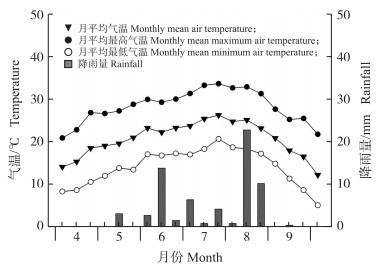
|
图 1 2018年海岛棉全生育期每月气温(平均、最高和最低)与降雨量情况 Fig. 1 Monthly temperature(mean, maximum and minimum)and rainfall of the island cottonduring the whole growth period in 2018 |
供试品种为‘新海43号’(XH 43)和‘新海49号’(XH 49), 前者在近年异常高温天气下种植, 具有较高的结铃率, 产量未受明显影响; 后者具有较好的产量品质性状, 表现出很强的生态适应性, 目前在南疆大面积种植。试验采用双因素随机区组设计, 3次重复。在花铃期开始增温处理, 以大田自然状态为对照(CK), 结合新疆南疆地区近37年高温天气的实际情况, 设置3 d(H3)、6 d(H6)、9 d(H9)3个增温水平。XH 43高温处理时间为7月5—15日; XH 49高温处理时间为7月13—23日。增温棚覆盖0.08 mm厚的塑料薄膜, 透光率为91%, 骨架最高处约1.5 m, 每小区面积32.5 m2, 种植密度为21.75万株·hm-2, 增温棚面积与小区相同, 每棚处理12行。增温处理期间, 每天11:00—20:00手动搭棚模拟高温环境。棚与地面保持0.3 m的高度, 以允许充分的气体交换和避免过度增温。温湿度记录仪(GM1365, 深圳市标智科技有限公司)挂在棚内、外距冠层上方30 cm处, 每1 h自动记录棚内气温, 高温处理期间棚内外平均气温见表 1, 搭棚期间棚内平均气温为36.60 ℃, 达到了高温胁迫; 棚外平均气温为31.98 ℃, 棚内平均气温比棚外高4.62 ℃, 每日最高气温超过35 ℃的时间超过6 h。处理达到相应持续时间(3、6、9 d)后拆除增温棚恢复到与对照一致的环境水平直至成熟。整个生育期肥水和病虫害管理均按大田进行。
| 品种 Variety |
指标 Item |
增温时间/d Time of warming | ||||||||
| 1 | 2 | 3 | 4 | 5 | 6 | 7 | 8 | 9 | ||
| 新海43号 Xinhai 43(XH 43) |
棚内Inside the shed | 37.11 | 36.82 | 36.06 | 36.70 | 37.66 | 35.87 | 33.81 | 37.37 | 37.74 |
| 棚外Outside the shed | 33.24 | 32.68 | 32.35 | 32.53 | 33.67 | 30.60 | 28.83 | 31.70 | 31.86 | |
| 新海49号 Xinhai 49(XH 49) |
棚内Inside the shed | 35.57 | 34.50 | 36.59 | 38.23 | 37.11 | 36.82 | 36.06 | 37.00 | 37.86 |
| 棚外Outside the shed | 30.74 | 29.65 | 31.07 | 32.54 | 33.24 | 32.68 | 32.35 | 32.53 | 33.54 | |
于海岛棉盛花(花)后0、10、20、30、40和50 d取样, 每小区取代表性较好的植株5株, 每部分按茎、叶、棉铃分样, 105 ℃杀青30 min, 85 ℃烘干至质量恒定后称质量。棉铃分配系数=棉铃干物质量/地上部干物质量。
1.2.2 成铃率与双铃率于成熟期每小区选定10株棉株调查每个果枝的成铃数。计算成铃率和双铃率:成铃率=该果枝成铃株数/10×100%, 双铃率=该果枝双铃株数/10×100%。
1.2.3 Logistic模型及其特征值棉铃发育过程中棉铃干物质积累随花后时间符合Logistic曲线, 其基本模型为:Y=Ym/(1+ae-bt)。式中, Y为棉铃干物质量; t为花后时间; Ym为棉铃最大理论干物质量; a、b为待定系数。其中棉铃快速积累期终止时间为:t=(ln a+1.317)/b。
1.2.4 产量及产量构成因素测定每小区定30株进行单株单铃收获, 统计单株铃数, 单铃称质量, 计算平均单铃质量; 然后轧花, 测定衣分。
1.3 数据统计与分析试验数据使用SPSS 23.0软件进行方差分析, 采用Duncan’s法进行处理间多重比较, 利用Origin 8.5软件整理数据并绘图。
2 结果与分析 2.1 花铃期高温胁迫对海岛棉地上部干物质积累与分配的影响如图 2所示:在花铃期高温胁迫下, XH 43和XH 49地上部干物质量均增加, 但不同增温条件下分配到各器官的干物质量存在差异。随着高温时间的增加, 棉铃干物质积累量下降, 但茎、叶干物质积累量却显著升高。在花后40 d, 两品种H6、H9处理的植株营养器官干物质量显著高于对照。在成熟期(花后50 d), XH 43在H6、H9处理中的茎和叶片干物质量比对照分别增加21.7%~26.5%和10.4%~19.5%, 在H3、H6和H9处理中棉铃干物质量比对照下降13.1%~43.2%;XH 49在H6、H9处理中茎和叶片干物质量比对照分别增加10.7%~19.8%和17.7%~60.6%, 在H3、H6和H9处理中棉铃干物质量比对照下降13.1%~49.4%。
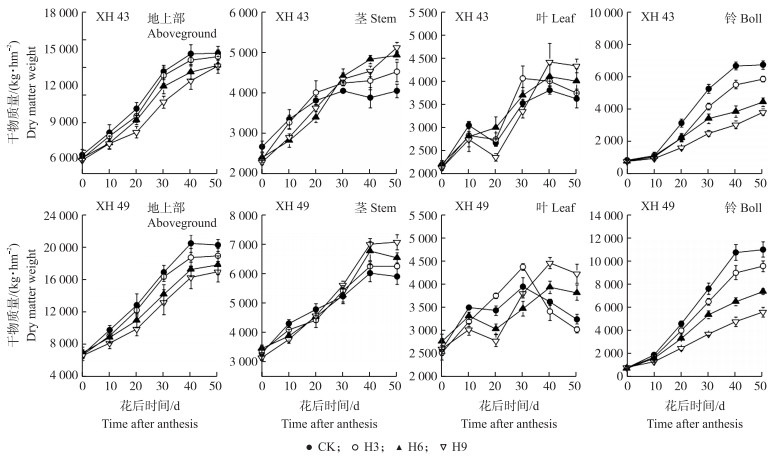
|
图 2 不同时间高温胁迫对海岛棉地上部干物质的积累与分配的影响 Fig. 2 Effects of heat stress for different time on dry matter accumulation of island cotton CK:大田自然条件Field natural condition; H3:高温胁迫3 d Heat stress for 3 d; H6:高温胁迫6 d Heat stress for 6 d; H9:高温胁迫9 d Heat stress for 9 d.下同。The same as follows. |
用Logistic生长函数对各处理棉铃干物质量积累进行拟合, 其拟合度均达到显著水平。由图 3可知:花铃期高温胁迫降低棉铃干物质量, 且到达棉铃快速积累期的终止时间延长。XH 43各处理(H3、H6和H9)棉铃分别在花后37、40和46 d达到快速积累期的终止时间, 比对照分别延长5、8和14 d; XH 49各处理(H3、H6和H9)棉铃分别在花后35、39和44 d达到快速积累期的终止时间, 比对照分别延长1、5和10 d。
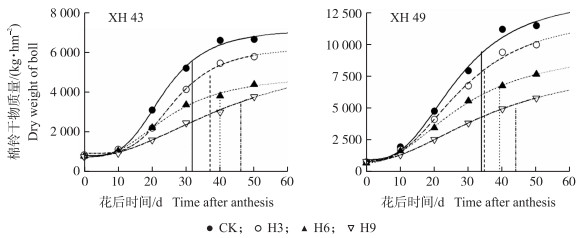
|
图 3 不同时间高温胁迫下棉铃干物质积累动态的Logistic曲线 Fig. 3 The Logistic curves of dry matter accumulation of cotton boll after heat stress 竖线表示到达快速积累期的终止时间。 The vertical bar reprent the end time of the rapid accumulation period. |
由图 4可知:不同时间高温胁迫后海岛棉棉铃分配系数总体呈对数变化趋势。XH 43和XH 49棉铃分配系数从大到小依次为CK、H3、H6、H9, 两品种H3、H6和H9处理盛花后30 d均与对照差异显著(P < 0.05);在花后40 d, CK和H3处理棉铃分配系数趋于平缓, 而H6和H9处理的棉铃分配系数依然呈上升趋势。表明高温胁迫使海岛棉棉铃分配系数降低, 但在生殖生长后期会出现上升的现象。
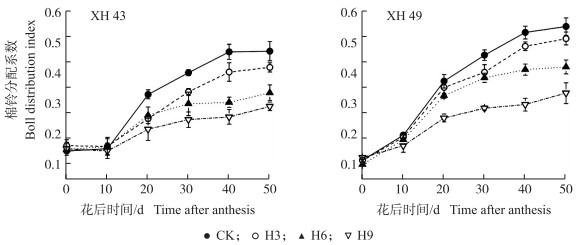
|
图 4 不同时间高温胁迫对海岛棉棉铃分配系数的影响 Fig. 4 Effects of heat stress for different time on the bolldistribution index of island cotton |
由图 5可知:花铃期高温胁迫对下部果枝的成铃率和双铃率影响较小, 但对中部果枝的成铃率和双铃率有显著影响。XH 43在H3、H6和H9处理的成铃率和双铃率分别比对照降低22.5%和37.5%、52.5%和81.25%、72.5%和81.25%;XH 49在H3、H6和H9处理的成铃率和双铃率比对照分别降低24.32%和52.63%、64.86%和89.47%、86.49%和94.74%。品种间, XH 43成铃率和双铃率在增温处理后的下降幅度小于XH 49, 表明XH 43具有较好的耐热性。在生殖生长后期, 两品种上部果枝在H6、H9处理的成铃率和双铃率显著高于对照, XH 43的成铃率和双铃率较对照分别增加44.44%和75.15%、66.67%和80.2%;XH 49的成铃率和双铃率较对照分别增加8.33%和12.5%、25%和12.5%。表明短期增温处理可促进棉株上部果枝成铃。
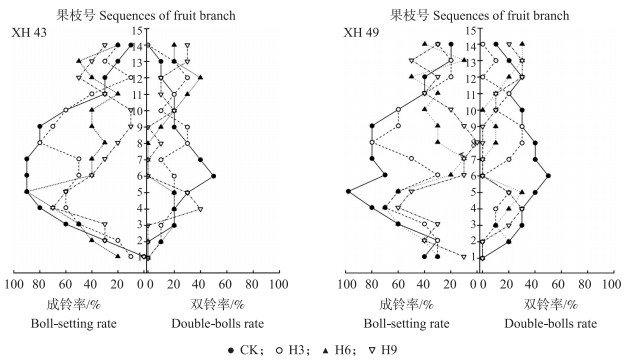
|
图 5 不同时间高温胁迫对海岛棉的成铃率与双铃率的影响 Fig. 5 Effects of heat stress for different time on boll-setting rateand double-bolls rate of island cotton |
由表 2可知:在产量构成因素中, 高温胁迫对海岛棉单株结铃数、单铃质量、衣分都具有显著影响。在H3、H6、H9处理中, XH 43和XH 49的单株结铃数较对照分别减少21.6%、22.4%、28.9%和16.6%、26.4%、34.7%, 籽棉产量较对照分别下降11.4%、20.5%、27.3%和12.0%、31.4%、44.4%, 籽棉产量的降低主要是由于单株结铃数分别减少所致。
| 品种 Variety |
处理 Treatment |
单株结铃数 Boll number per plant |
单铃质量/g Boll weight |
衣分/% Lint percentage |
籽棉产量/(kg·hm-2) Seed cotton yield |
| XH 43 | CK | 10.72±0.65a | 2.82±0.04ab | 0.33±0.01a | 5 389.35±234.05a |
| H3 | 8.40±0.11b | 2.91±0.06a | 0.32±0.02ab | 4 772.85±281.70b | |
| H6 | 8.31±0.47bc | 2.61±0.04b | 0.31±0.02ab | 4 285.95±267.95c | |
| H9 | 7.62±0.28c | 2.58±0.08b | 0.30±0.02b | 3 917.70±263.70c | |
| XH 49 | CK | 11.22±0.19a | 2.90±0.05a | 0.34±0.01a | 5 913.45±251.55a |
| H3 | 9.36±0.27b | 2.84±0.03a | 0.33±0.02ab | 5 203.20±130.90b | |
| H6 | 8.26±0.26c | 2.51±0.07b | 0.31±0.03b | 4 054.35±234.45c | |
| H9 | 7.33±0.50d | 2.30±0.03b | 0.31±0.01b | 3 287.85±183.90d | |
|
注:不同小写字母表示处理间在0.05水平差异显著。 Note:Different small letters indicate significant difference among treatment at 0.05 level. |
|||||
从图 6可见:花铃期不同时间高温胁迫下营养器官干物质积累与籽棉产量存在负相关关系, 说明虽然籽棉产量随增温时长的增加而降低, 但营养器官积累量逐渐升高。由回归方程斜率可知, XH 43(R2=0.88)在高温胁迫下每单位营养器官干物质积累量的增加对籽棉产量的贡献大于XH 49(R2=0.83)。
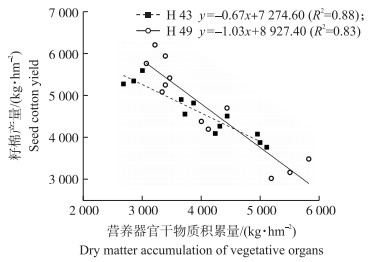
|
图 6 不同时间高温处理下籽棉产量与花后营养器官干物质积累的关系 Fig. 6 The relationship between seed cotton yield and dry matter accumulationfollowing anthesis after heat stress |
棉花的生长发育与温度密切相关, 不同的温度变化不仅影响棉铃的数量和质量, 同时也调节植株营养生长的状况[18]。干物质是作物光合生产的表现形式, 是作物产量形成的基础, 其物质积累与合理分配是提高作物产量的关键[19]。
相关研究发现, 高温加速植株生长, 缩短碳同化和棉铃生长时间, 从而导致棉株生理性早衰及干物质积累下降[20]。亦有报道认为, 开花期高温胁迫下营养器官的干物质积累量随温度增加和持续时间延长呈升高趋势[21]。本试验中, 随高温时间的增加, 营养器官与生殖器官干物质量均呈下降趋势。这可能与高温胁迫对叶片光合机构造成破坏, 导致光合作用减弱、呼吸作用增强以及蕾铃大量脱落有关[22]。但在生殖生长后期, H6和H9处理海岛棉茎和叶片干物质量均较对照显著上升。这可能是由于棉铃库容量的减少, 使生殖生长后期叶片光合产物无法继续向棉铃输送, 进而导致后期叶片生物量较高, 且部分光合产物在茎中堆积[23]。短期高温胁迫后, 光合生产仍然是生殖器官生长的主要来源。Sadras[24]认为, 增强光合作用能提高作物光合有效辐射利用率, 这是补偿生长的重要组成部分。本试验条件下, 随高温时长的增加, 棉铃干物质进入快速积累期的终止时间滞后, 铃期延长, 这可能与后期叶片光合产物无法转运, 叶片衰老缓慢, 使叶片后期仍能保持较高的光合速率有关[25]。
棉花的生殖生长对高温胁迫非常敏感, 其中花粉的最适温度为28 ℃, 大于35 ℃高温持续数日则会迅速降低其育性, 并降低单株结铃数及单铃质量, 从而严重影响产量[26]。贺新颖等[27]研究认为, 单株结铃数是对高温最敏感的产量构成因素, 高温条件下籽棉产量下降主要是由铃数减少导致, 本试验结果与之一致。但花铃期短期高温胁迫后, 棉株上部果枝成铃数在生殖生长后期略有增加, 这可能是由于后期营养器官分配指数较高, 植株衰老缓慢, 从而延长了花蕾的产生, 增加晚花率和结铃率, 以补偿早期的产量损失[28]。本研究中, 蕾铃对温度的敏感性明显高于营养器官, 同时发现高温胁迫后营养器官的生理功能可能受到库活性的影响。不同海岛棉品种籽棉产量对高温胁迫的响应存在较大差异, 高温条件下使单株结铃数和单铃质量显著下降, 其中XH 49的下降幅度大于XH 43。同时XH 43在高温胁迫后的优势还在于叶片衰老缓慢, 上部果枝成铃数增幅较大, 能较好地补偿产量损失。
综上所述, 花铃期短期(3~9 d)高温胁迫严重限制了棉铃干物质的积累及产量的形成。受前期高温胁迫的影响, 后期营养器官干物质量的增加促进上部果枝成铃, 补偿了部分产量的损失。本文尚未涉及上部果枝单铃质量及纤维品质的变化, 还有待今后研究。
| [1] |
Tubiello F N, Soussana J F, Howden S M. Crop and pasture response to climate change[J]. Proc Natl Acad Sci USA, 2007, 104(50): 19686-19690. DOI:10.1073/pnas.0701728104 |
| [2] |
秦大河, Thomas Stocker. IPCC第五次评估报告第一工作组报告的亮点结论[J]. 气候变化研究进展, 2014, 10(1): 1-6. Qin D H, Stocker T. Highlights of the IPCC Working GroupⅠFifth Assessment Report[J]. Climate Change Research, 2014, 10(1): 1-6 (in Chinese with English abstract). DOI:10.3969/j.issn.1673-1719.2014.01.001 |
| [3] |
王秀琴, 段维. 新疆莫索湾高温日数统计特征[J]. 干旱气象, 2014, 32(2): 220-225. Wang X Q, Duan W. Statistical characteristics of high temperature days in Mosuowan of Xinjiang[J]. Journal of Arid Meteorology, 2014, 32(2): 220-225 (in Chinese with English abstract). |
| [4] |
黄帅, 江静. 中国持续性高温事件的时空分析[J]. 南京大学学报(自然科学版), 2012, 48(6): 689-700. Huang S, Jiang J. The spatial-temporal analysis of persistent high-temperature events in China[J]. Journal of Nanjing University(Natural Science), 2012, 48(6): 689-700 (in Chinese with English abstract). |
| [5] |
Bhatt J G. Growth and flowering of cotton(Gossypiurn hirsuturn L.) as affected by daylength and temperature[J]. Journal of Agricultural Science, 1977, 89: 583-587. DOI:10.1017/S0021859600061360 |
| [6] |
孙啸震, 张黎妮, 戴艳娇, 等. 花铃期增温对棉花干物重累积的影响及其生理机制[J]. 作物学报, 2012, 38(4): 683-690. Sun X Z, Zhang L N, Dai Y J, et al. Effect of increased canopy temperature on cotton plant dry matter accumulation and its physiological mechanism[J]. Acta Agronomica Sinica, 2012, 38(4): 683-690 (in Chinese with English abstract). |
| [7] |
杨威, 朱建强, 吴启侠, 等. 花铃期短期渍水和高温对棉花叶片光合特性、膜脂过氧化代谢及产量的影响[J]. 棉花学报, 2016, 28(5): 504-512. Yang W, Zhu J Q, Wu Q X, et al. The effect of short-term waterlogging and high temperature on photosynthesis, membrane lid peroxidation metabolism, and yield during cotton flowering and boll-forming[J]. Cotton Science, 2016, 28(5): 504-512 (in Chinese with English abstract). |
| [8] |
Wardlaw I F. Interaction between drought and chronic high temperature during kernel filling in wheat in a controlled environment[J]. Annals of Botany, 2002, 90(4): 469-476. DOI:10.1093/aob/mcf219 |
| [9] |
Kumar R, Sarawgi A K, Ramos C, et al. Partitioning of dry matter during drought stress in rainfed lowland rice[J]. Field Crops Research, 2006, 96(2/3): 455-465. |
| [10] |
Oosterhuis D M. Day or night high temperatures:a major cause of yield variability[J]. Cotton Grower, 2002, 46: 8-9. |
| [11] |
Ohe I, Saitoh K, Kuroda T, et al. Effects of high temperature on growth, yield and dry-matter production of rice grown in the paddy field[J]. Plant Production Science, 2007, 10(4): 412-422. DOI:10.1626/pps.10.412 |
| [12] |
Ali M, Nicieza A, Wootton R J. Compensatory growth in fishes:a response to growth depression[J]. Fish and Fisheries, 2003, 4(2): 147-190. DOI:10.1046/j.1467-2979.2003.00120.x |
| [13] |
李留勇.不同生育期高温处理对水稻生长及产量形成的影响[D].武汉: 华中农业大学, 2015. Li L Y. Effects of high temperature treatments at different growth stages on the growth and yield formation of rice[D]. Wuhan: Huazhong Agricultural University, 2015(in Chinese with English abstract). |
| [14] |
Acevedo E, Hsiao T C, Henderson D W. Immediate and subsequent growth responses to maize leaves to changes in water status[J]. Plant Physiology, 1971, 48: 631-636. DOI:10.1104/pp.48.5.631 |
| [15] |
Shah F, Nie L, Cui K, et al. Rice grain yield and component responses to near 2℃ of warming[J]. Field Crops Research, 2014, 157: 98-110. DOI:10.1016/j.fcr.2013.12.014 |
| [16] |
Wang X, Cai J, Jiang D, et al. Pre-anthesis high-temperature acclimation alleviates damage to the flag leaf caused by post-anthesis heat stress in wheat[J]. Journal of Plant Physiology, 2011, 168(6): 585-593. DOI:10.1016/j.jplph.2010.09.016 |
| [17] |
Ordóñez R A, Savin R, Cossani C., et al. Yield response to heat stress as affected by nitrogen availability in maize[J]. Field Crops Research, 2015, 183: 184-203. DOI:10.1016/j.fcr.2015.07.010 |
| [18] |
贺怀杰, 王振华, 郑旭荣, 等. 水氮耦合对膜下滴灌棉花生长及产量的影响[J]. 新疆农业科学, 2017, 54(11): 1983-1989. He H J, Wang Z H, Zheng X R, et al. Effects of water-nitrogen coupling on growth and yield of cotton under mulch drip irrigation[J]. Xinjiang Agricultural Sciences, 2017, 54(11): 1983-1989 (in Chinese with English abstract). DOI:10.6048/j.issn.1001-4330.2017.11.003 |
| [19] |
陈军晓, 张保军, 张正茂, 等. 不同栽培模式对冬小麦干物质积累及籽粒灌浆特性的影响[J]. 西北农业学报, 2017, 26(12): 1776-1786. Chen J X, Zhang B J, Zhang Z M, et al. Effect of different cultivation patterns on dry matter accumulation and grain filling characteristics in winter wheat[J]. Acta Agriculturae Boreali-Occidentalis Sinica, 2017, 26(12): 1776-1786 (in Chinese with English abstract). DOI:10.7606/j.issn.1004-1389.2017.12.006 |
| [20] |
Rawson H. Plant responses to temperature under conditions of elevated CO2[J]. Australian Journal of Botany, 1992, 40(5): 473-490. DOI:10.1071/BT9920473 |
| [21] |
Shi P H, Zhu Y, Tang L, et al. Differential effects of temperature and duration of heat stress during anthesis and grain filling stages in rice[J]. Environmental and Experimental Botany, 2016, 132: 28-41. DOI:10.1016/j.envexpbot.2016.08.006 |
| [22] |
Kakani V G, Reddy K R, Koti S, et al. Differences in in vitro pollen germination and pollen tube growth of cotton cultivars in response to high temperature[J]. Annals of Botany, 2005, 96(1): 59-67. DOI:10.1093/aob/mci149 |
| [23] |
Kim J, Shon J, Lee C K, et al. Relationship between grain filling duration and leaf senescence of temperate rice under high temperature[J]. Field Crops Research, 2011, 122(3): 207-213. DOI:10.1016/j.fcr.2011.03.014 |
| [24] |
Sadras V O. Compensatory growth in cotton after loss of reproductive organs[J]. Field Crops Research, 1995, 40: 1-18. DOI:10.1016/0378-4290(94)00088-T |
| [25] |
宋桂成, 王苗苗, 曾斌, 等. 高温对棉花生殖过程的影响[J]. 核农学报, 2016, 30(2): 404-411. Song G C, Wang M M, Zeng B, et al. The effects of high-temperature on reproductive process in upland cotton[J]. Journal of Nuclear Agricultural Sciences, 2016, 30(2): 404-411 (in Chinese with English abstract). |
| [26] |
郑冬官, 方其英, 蔡永立, 等. 高温对棉花花粉生活力的影响[J]. 棉花学报, 1995, 7(1): 31-32. Zheng D G, Fang Q Y, Cai Y L, et al. Effect of high temperaturse on cotton pollen viability[J]. Acta Gossypii Sinica, 1995, 7(1): 31-32 (in Chinese with English abstract). |
| [27] |
贺新颖, 周治国, 戴艳娇, 等. 铃期增温对棉花产量、品质的影响及其生理机制[J]. 应用生态学报, 2013, 24(12): 3501-3507. He X Y, Zhou Z G, Dai Y J, et al. Effects of bolling temperature on cotton yield and quality and its physiological mechanism[J]. Journal of Applied Ecology, 2013, 24(12): 3501-3507 (in Chinese with English abstract). |
| [28] |
Ungar E D, Wallach D, Kletter E. Cotton response to bud and boll removal[J]. Agronomy Journal, 1987, 79: 491-497. DOI:10.2134/agronj1987.00021962007900030017x |




